This engineer spent RM120K to open a PJ cafe that lets guests rent books for RM5/each
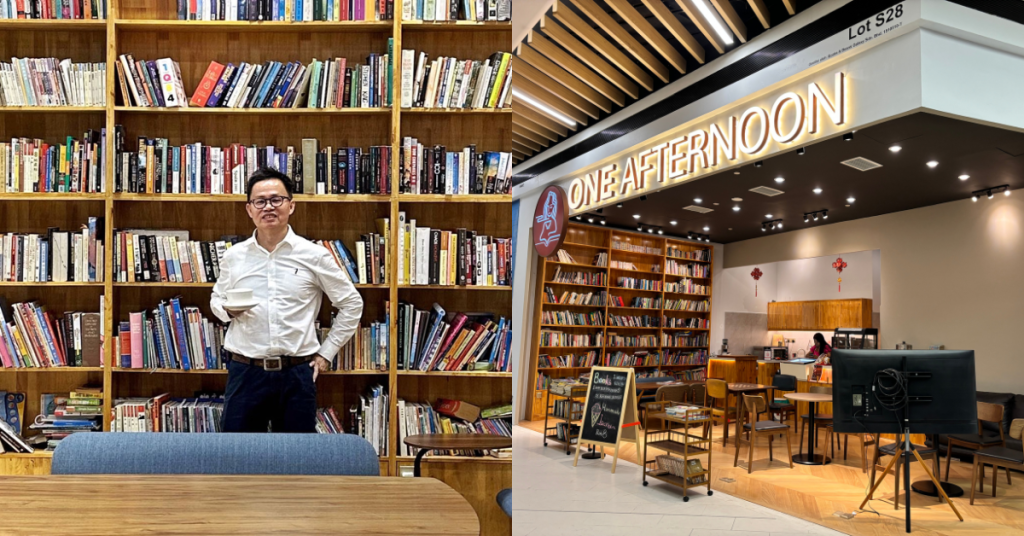
A new café has opened in Damansara Jaya’s Atria Shopping Gallery, and it’s not just any café. Rather, it’s a book café.
Named One Afternoon, it was founded by Ben Lim, an electrical & electronic engineering graduate.
Before starting the cafe, Ben also founded MyTaman and Pegasuswork, two apps used in 400 or so property development projects in Malaysia.
According to Ben, MyTaman, which has visitor management and panic button assist features, are used by most tamans in Damansara Jaya, with approximately 5,000 users.
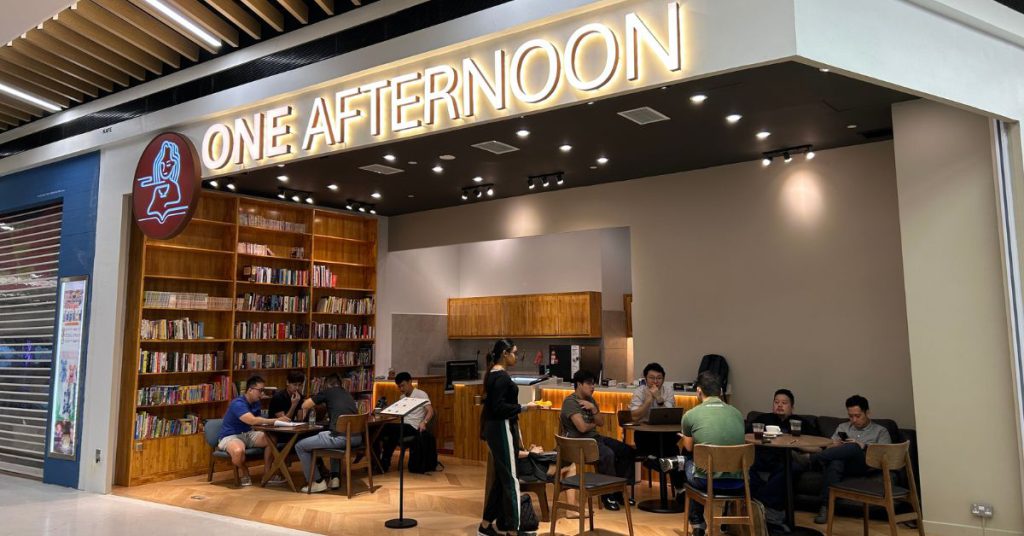
Utilising income generated from MyTaman, One Afternoon was launched on January 1, 2024 with a capex of around RM120K.
When asked about the cafe’s name, Ben shared, “I was reading a book about Taiping and its surrounding township Kuala Sepetang (Port Weld) where my old man was a fisherman.”
Then, it occurred to him that the Sepetang in Kuala Sepetang meant one afternoon.
Ben mused, “I felt it was romantic, and being a fisherman’s son, the name has its sentimental value for me.”
But why a book cafe?
If you’re a parent in PJ like Ben is, you’ll know that weekends are often spent in shopping malls.
However, Ben has noticed that in the area and its many shopping malls, there aren’t any with a book café concept where parents can chill out with a drink while their kids read books (instead of being chained to their mobile phones).
The closest, he argued, would be Eslite Spectrum in The Starhill.
“One Afternoon is to provide the solution to that problem,” the founder said.
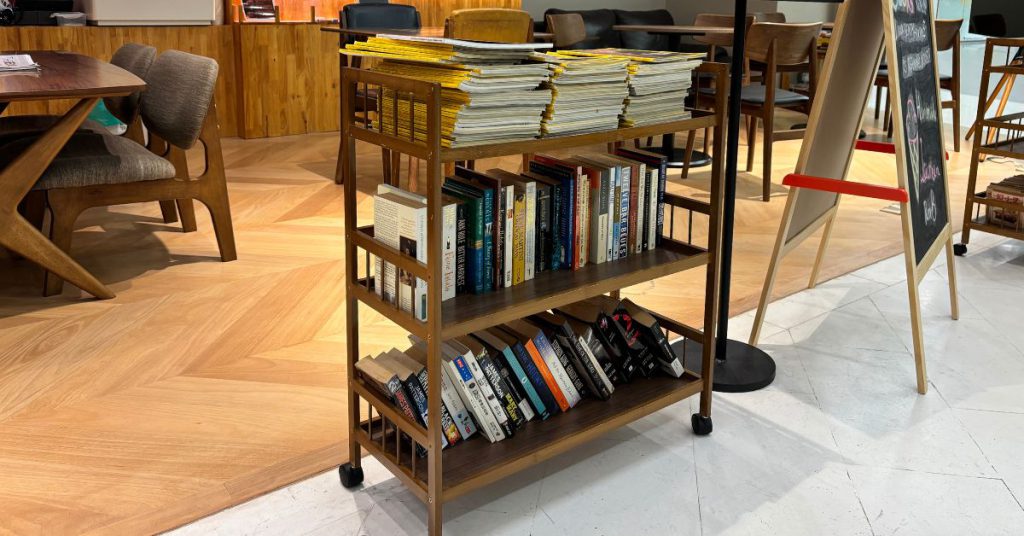
Plus, both Ben and his daughter are avid readers, so much so that they’ve been running out of space at home to keep their books. One Afternoon thus aligns with their interest (as well as helps solve their space issue).
“Although 1/3 of the books are from my own collection, I am blessed to be staying in the Damansara Jaya area,” he said. “When I told [the community] I have a book cafe in the WhatsApp group, the donated books started sort of flying in.”
Ben shared that he was quite surprised by the range of titles One Afternoon has collected thus far, but it makes sense because they’ve been donated by people from all walks of life.
Some titles he highlighted include 1Q84 by Haruki Murakami, The Alchemist by Paulo Coelho, and Surely You’re Joking, Mr Feynman! by Richard Feynman.
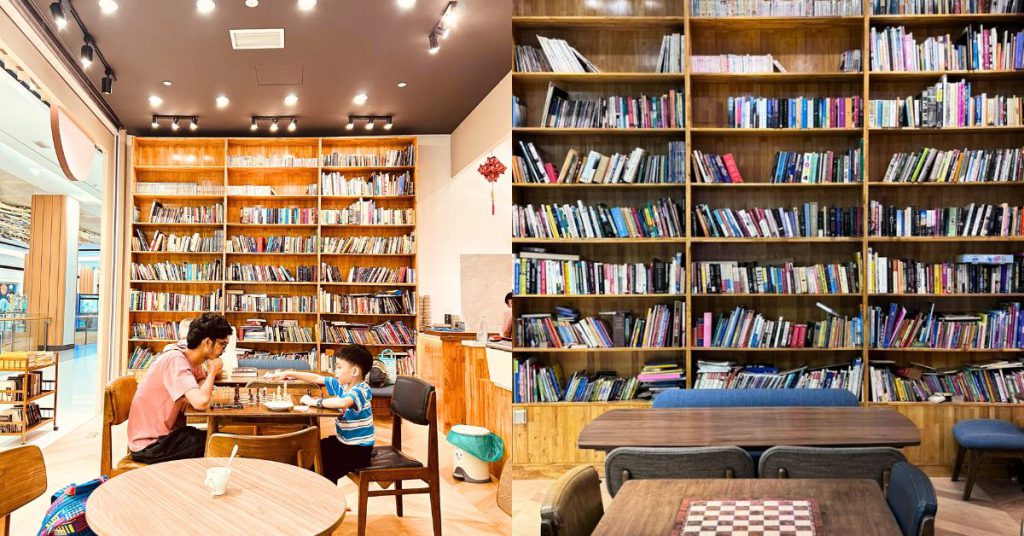
Aside from its array of books, One Afternoon serves up artisan coffee, pastries, as well as cookies and ice cream made by Ben’s wife.
Apparently, their signature Cempedak ice cream has already attracted some return customers.
One core offering at One Afternoon is their coffee that comes bundled with a cookie or ice cream.
“From my own experience, when we parents go to any café, we have a limited choice of what to order for our noisy kids,” Ben pointed out. “Hence the bundled strategy, which will buy a few minutes of peaceful reading time.”
A library system
More than just a café where you can read books, One Afternoon actually functions similarly to a library. That means readers can bring borrowed books home.
The current system is rather manual, involving a physical book rental where details like the book title, date, borrower’s name, and contact are penned down.
Going forward, Ben does have plans to digitalise the process, which should be easy given his background.
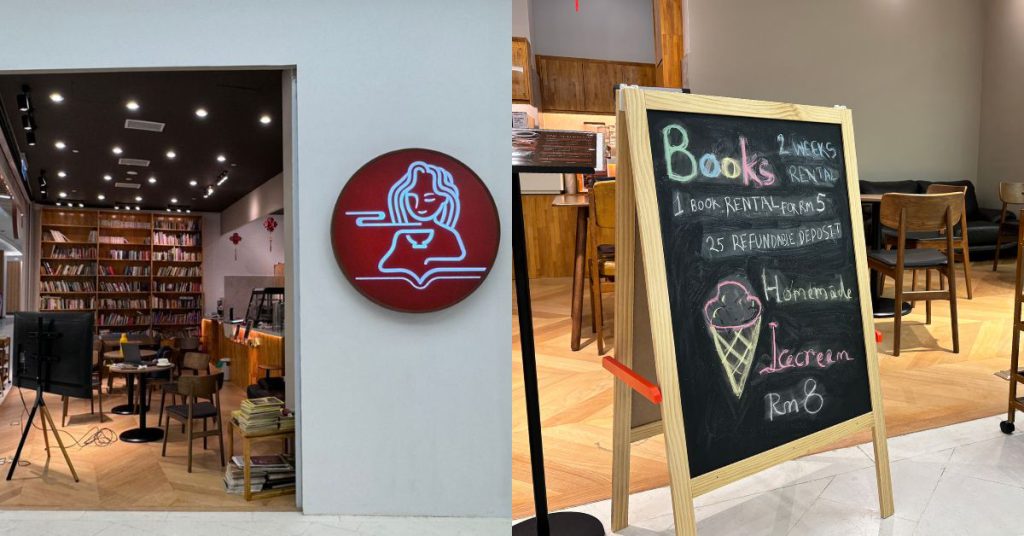
Each book rental is RM5. To ensure borrowers return their books, there’s a one-time RM25 deposit. This deposit is not per book, but per person.
Borrowers are given two weeks, but their deposits wouldn’t be voided as long as the book is returned, even if it’s later than the deadline.
“So, as we do not void the deposit and do not have penalties if the customer borrows for more than two weeks, our offer of RM5 book rental per book should still be attractive to book readers,” Ben explained.
For the neighbourhood
Ben believes that the Atria Shopping Gallery location is ideal for their target audience of families with children.
Located on the second floor, it’s just a stone’s throw away from a piano centre, a pet shop, a jungle gym, and even a preschool. This, Ben believes, gives One Afternoon the foot traffic they need.
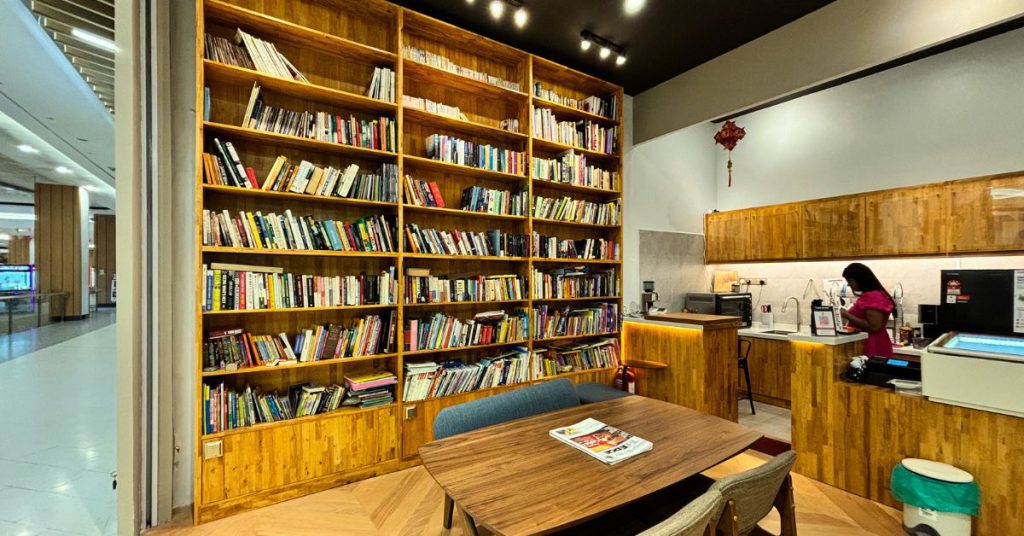
“Currently, we want to be very focused in Atria only, but maybe with additional space where we can turn into coworking or lifestyle concepts,” Ben added.
The founder believes that keeping to a single location but possibly having a bigger space will keep overhead low.
Ben also engages an online-to-offline strategy, making use of the MyTaman app’s news channel to reach out to prospective customers. The founder understands that social media marketing through TikTok, Instagram, and Facebook will be key too.
Aside from that, they’re relying on word of mouth for return customers. One Afternoon will also have monthly events, ranging from blockchain events to chess clinics.
Designed for Damansara Jaya residents by a resident himself, the One Afternoon book café hopes to be a place where community members can visit, not just one, but any afternoon.
Also Read: The Tokyo govt wants to grow MY & SG startups in Japan, here’s how entrepreneurs can benefit
Featured Image Credit: One Afternoon
Singapore’s top vacancies: Ministry of Manpower releases a list of the most in-demand jobs
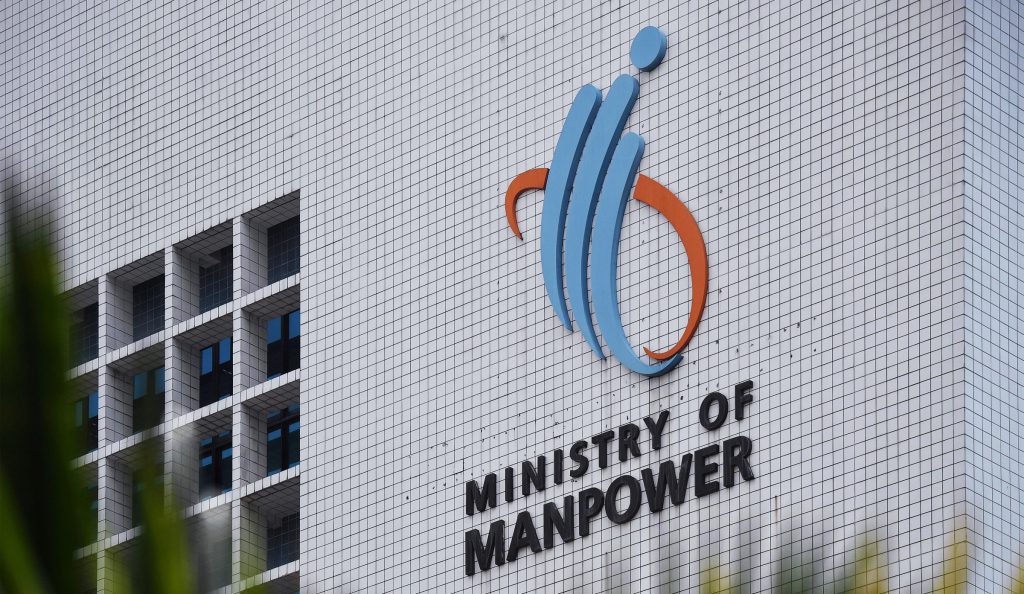
Ministry of Manpower has just released its annual summary of the trends in job vacancies in Singapore, together with a list of the professions seeking the most positions that companies seek to fill.
The survey is very comprehensive, having covered private sector companies which employ at least 25 people and the public sector comprising government ministries and statutory boards.
A total of 16,800 establishments employing 2,168,900 employees responded to the survey, with a response rate of 89.0%, between 15 September 2023 and 19 December 2023.
Here’s the breakdown of the findings:
New job creation picks up
2023 was the best year for new job vacancies since 2018 when the figure was first reported. Nearly half, 47.3 per cent, were new positions.
The slight dip in 2022 is somewhat understandable, given the post-pandemic hiring spree, which was all about filling the jobs that were lost in the pandemic, but the bump vs. pre-pandemic levels shows high levels of optimism even as Singapore economy is now employing more people than ever.
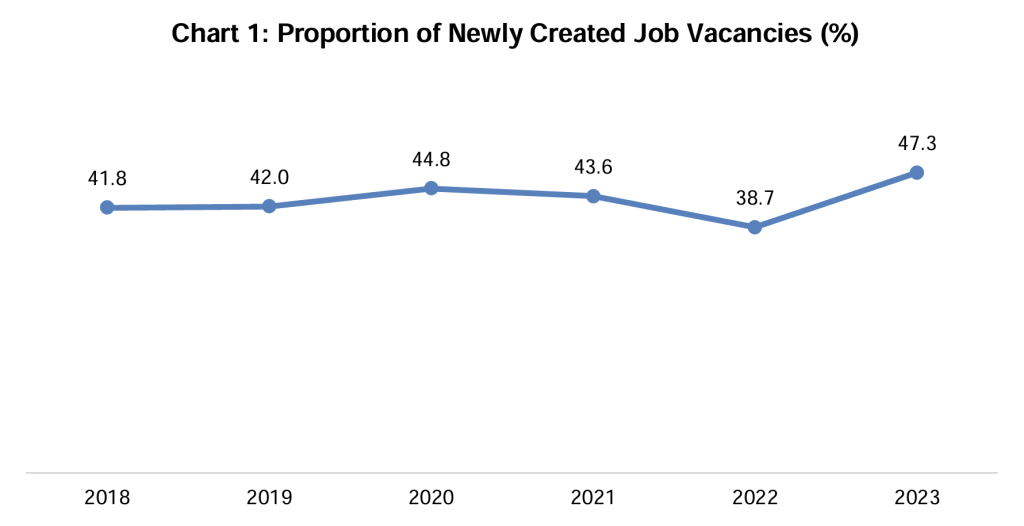
Where are those new jobs created?
Unsurprisingly, the industry with the highest proportion of new openings remains the ICT sector, which is forever hungry for more IT talent. Nearly three out of four openings were created over the past year. It’s no surprise then that even fresh graduates can expect starting salaries of $5000 to over $6000 per month.
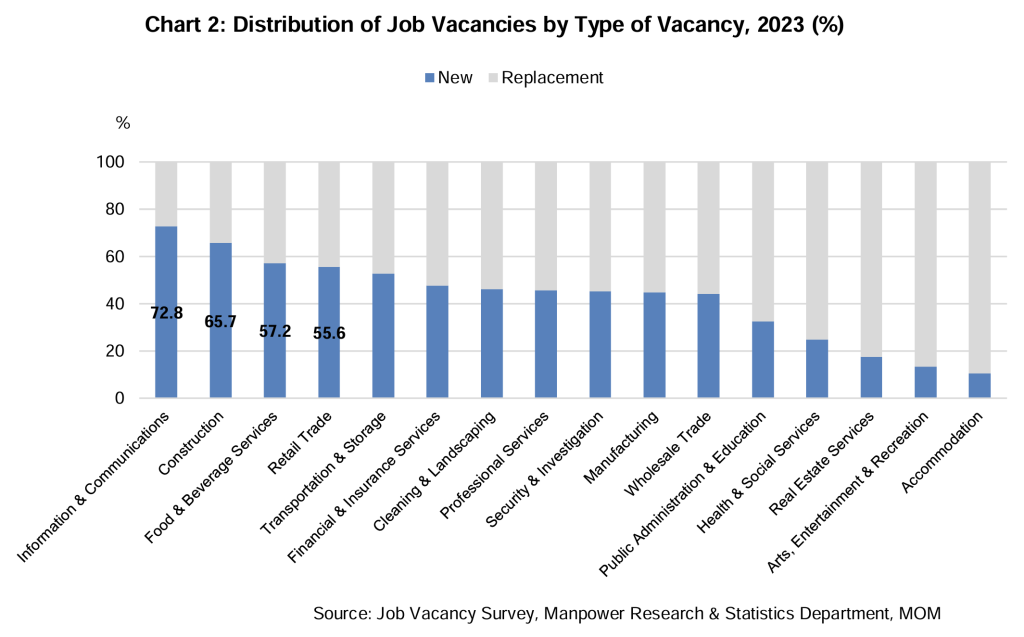
In second place comes the still booming construction sector, although, with cooling measures taking greater effect, this may taper off in the coming year or two.
Interestingly, food and beverage services and retail trade are also hiring more than they are simply replacing, followed closely by transportation and finance, the bedrock of the Singapore economy.
On the opposite end, real estate is showing signs of saturation, as is accommodation and arts & recreation, still seeking to fill the post-pandemic gaps, as travel to Singapore is back to 2019 levels and set to grow in the coming years.
PMETs in demand
It’s quite remarkable that as recently as 2017 non-PMET vacancies still outnumbered the PMET jobs on offer. Within a decade since 2014, the proportions have reversed, showing a progressing professionalisation and uplift of Singapore’s labour force, as more and more jobs require more advanced expertise (driven mostly by the tech sector).
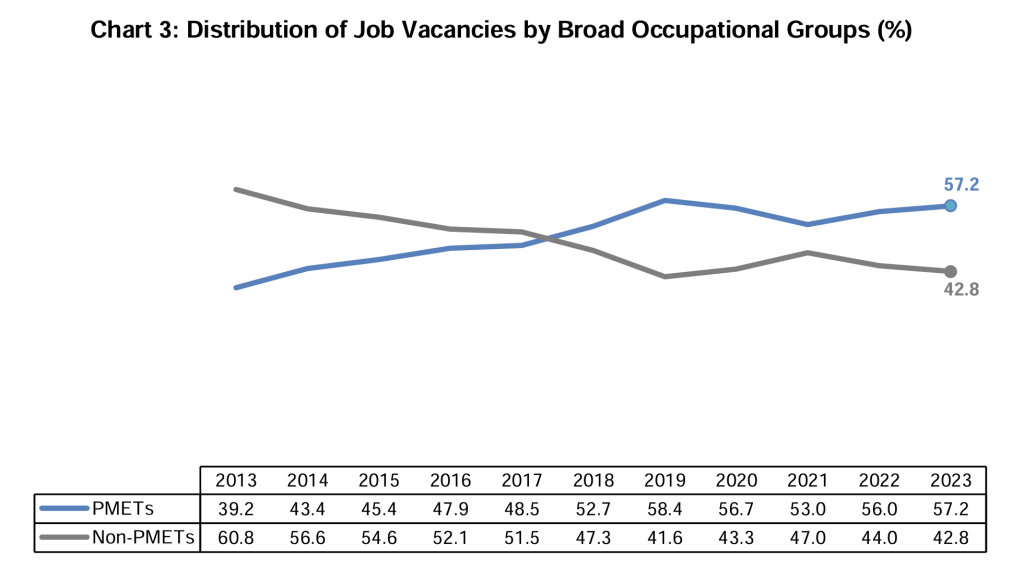
Obstacles to employment
We often hear that many seemingly good, decent jobs for professionals are picked up by foreigners, but there are certain reasons why local residents (citizens and permanent residents) either refuse or simply can’t fill them.
And, as it is often cited by employers, the main reasons are the lack of skills or experience, with insufficient pay being the cause in just 1/3rd of all cases of vacancies remaining on the market for more than six months.
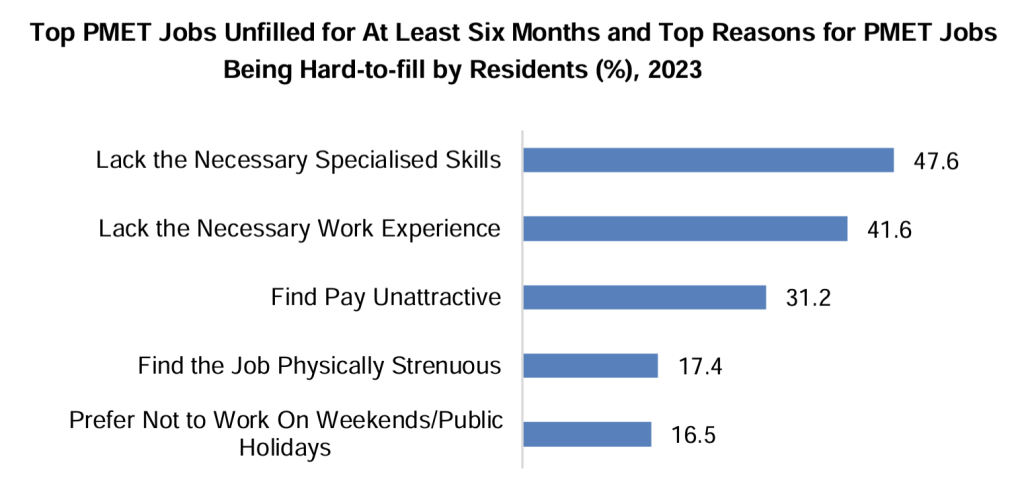
Degrees matter less and less
Reflecting global trends, another revolution in Singapore’s labour market is the rapid decline in the importance of academic qualifications.
Of course, this was never a major factor for most non-PMET jobs, but since 2017 it has very rapidly become a non-issue for PMET positions as well.
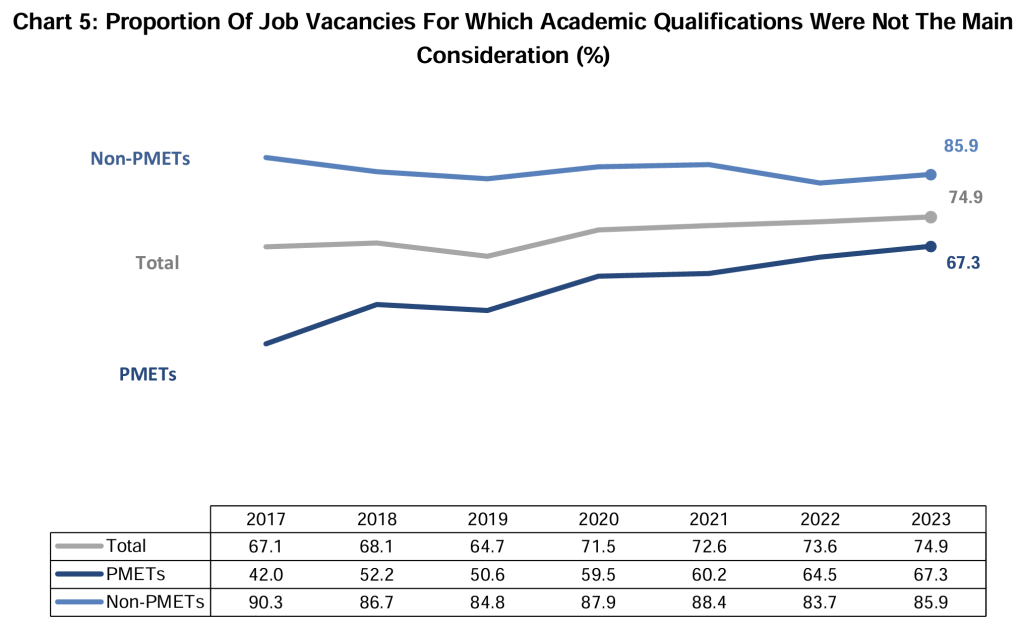
From just nearly 60 per cent seven years ago to just 33 per cent today — this is how rapidly the importance of your formal education has declined.
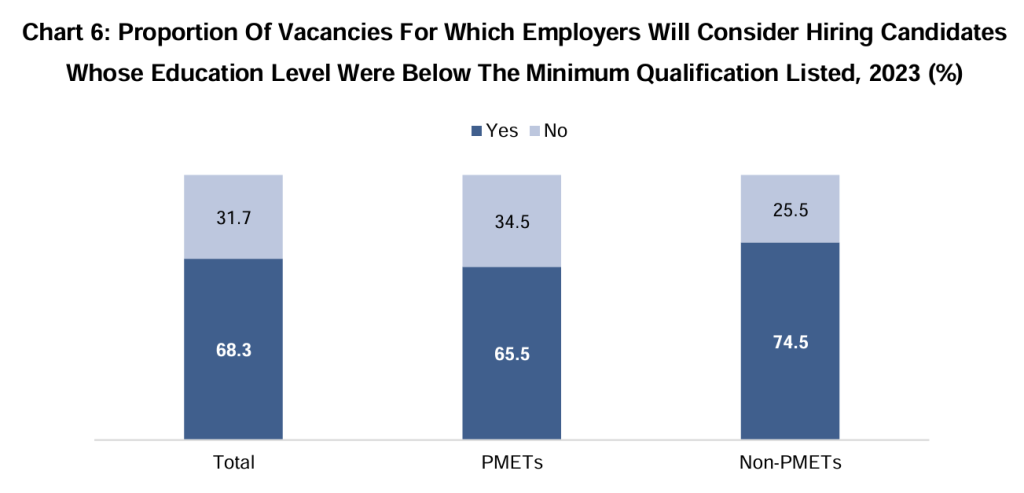
For two-thirds of all vacancies, even among professionals, employers will consider candidates who do not command the necessary basic education for the role, provided that they can offer other valuable traits. Businesses place greater emphasis on experience and real-life skills rather than paper qualifications, and that seems to be both fairer candidates and better for the economy.
Top vacancies with expected salaries
According to MOM, educational background is not the main consideration chiefly among software and media developers, management executives, business development managers, sales executives, and even some teaching and training professionals.
Incidentally, all of them are on the list below:
Top 10 PMET Vacancies
| Rank | Occupation | Range of wages offered |
| 1 | Software, Web & Multimedia Developer | $5,000 to $8,505 |
| 2 | Teaching & Training Professional | $3,080 to $8,580 |
| 3 | Commercial & Marketing Sales Executive | 3,000 to $4,200 |
| 4 | Management Executive | $2,400 to $6,250 |
| 5 | Budgeting & Financial Accounting Manager | $7,000 to $10,000 |
| 6 | Industrial & Production Engineer | $4,000 to $6,500 |
| 7 | Management & Business Consultant | $5,000 to $8,000 |
| 8 | Systems Analyst | $5,500 to $9,663 |
| 9 | Registered Nurse & Other Nursing Professional | $2,730 to $5,000 |
| 10 | Business Development Manager | $6,000 to $10,000 |
This proves that not only does the labour market reward skills and experience more than paper qualifications, but that education in Singapore should place greater emphasis on developing practical competences from a young age to future-proof the new generations for growing international competition.
After all, if you don’t evolve, you’re not only standing still—you’re falling behind.
Paralysed Neuralink patient plays Civilization VI for 8 hours with his mind thanks to brain implant

Following many months of controversy surrounding the thus far rather secretive Elon Musk venture, Neuralink, the company has run a 9-minute live broadcast on X with the first patient who received one of its implants — and the reveal was more than promising.
29-year-old Noland Arbaugh suffered a broken spine in a diving accident eight years ago, leaving him quadriplegic: completely paralysed from the neck down. The consequences and resultant dependence on others for just about everything need not be explained here, of course, so every invention that permits the patient to communicate with a machine is a life-changer.
Neuralink’s stated goal is “creating a general-purpose, high-bandwidth interface to the brain”, which would allow all humans to communicate with computers directly via thoughts rather than typing or talking.
That said, the obvious candidates for early testing are those most in need of such a technology to return to doing most basic things in life.
In the long run, it may even be possible to use this innovation to fully restore motor function in paralysed patients one day, as per Elon Musk’s comment under the video:
As of now, however, even doing as little as being able to control a laptop is an enormous improvement in the quality of everyday life.
Using the Force
So, how does it work? What does it feel like? Noland explained that it’s like using the Force in Star Wars movies — you just command the cursor to move where you want it to wirelessly, with nothing else but your thoughts (and no cables sticking out of your head, like in the past).
The process is a bit more complex, of course, and initially involves visualising movement and imagining what you would do to make the cursor move to the place you want, while the implant learns to translate your intent into motion on the screen.
But once it’s been dialled in, it becomes intuitive. So intuitive, in fact, that once he got his implant under control, he stayed up for 8 hours straight playing Civilisation VI while lying in his bed.
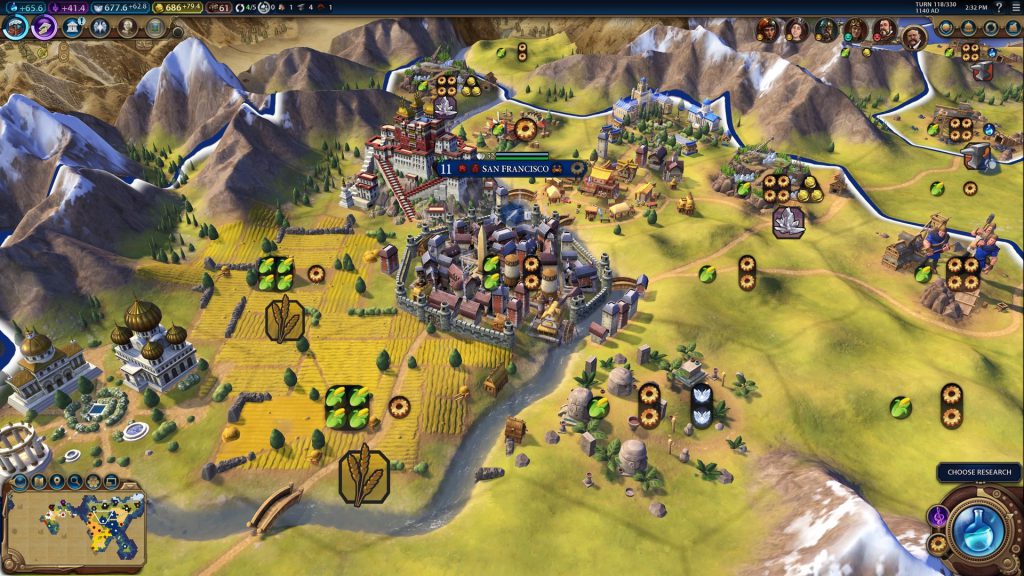
He’s also playing online chess with other players on the internet and is learning Japanese and French.
Long sessions at the computer were previously difficult, since lack of motion for many hours causes pressure sores and requires assistance from family to move his body around even in the wheelchair.
Right now, however, he can stay comfortably in bed, relying on himself to control the computer with nothing but his thoughts. The only limitation is the implant’s battery, which needs to be recharged periodically.
He admits that not everything was smooth sailing and it’s still a work in progress, but the impact it has had on his life is profound:
“I would say that we have run into some issues. I don’t want people to think that it is the end of the journey, there’s still a lot of work to be done, but it has already changed my life.”
Noland Arbaugh
Even the initial surgery, while invasive, went well and Noland was out of hospital after just one day.
The same cannot, probably, be said of the monkeys Neuralink is using to develop another implant: one whose aim is restoring sight.
Monkeys see again?
Following the broadcast Elon went on to introduce another product, called Blindsight, dedicated to patients who had either lost their sight or were born blind.
As he explained in a short video clip attached to the post, “the visual part of the cortex is still there”, so that even in extreme cases of blindness at birth, sight may eventually be restored.
The implant is currently being tested in monkeys and, per Musk, “is already working”. The billionaire took the opportunity to jab back at his critics, after allegations of animal abuse and numerous deaths of test subjects (monkeys) cast shadow on Neuralink’s practices.
That said, if the early results are anything to go by, then even if that happens occasionally, it is perhaps a small price to pay for the life-changing effects the company’s technology may have on humans.
Featured Image Credit: Neuralink
Also Read: xAI: Elon Musk launches new AI company – unites powerhouses from OpenAI, Google, Microsoft
Tapping into “geekdom”, this S’porean artisanal dice brand has found a global audience
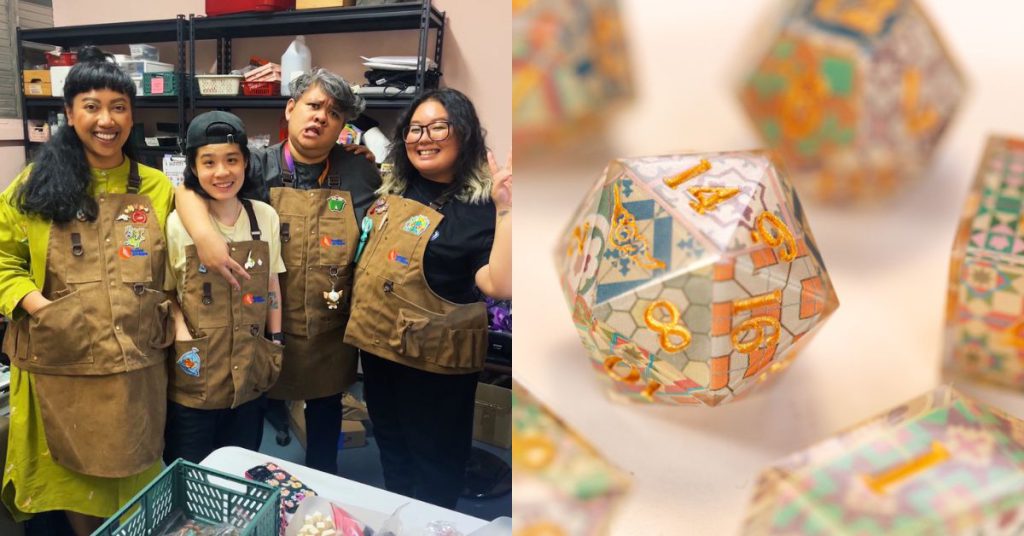
While somewhat niche, tabletop roleplaying games (TTRPG) have continued to have a lasting grip on pop culture. From the 2023 movie Dungeons & Dragons: Honour Among Thieves, to popular game shows like Dropout’s Dimension 20 and Critical Role, there’s clearly a sizeable market who play these games.
And a crucial part of these games are the dice.
Compared to your usual six-face dice, tabletop games’ dice can go up to 20 faces, making them rather specialised. And with this specialisation comes many artisanal and custom options in the market.
Among these is Sambal & Mages, a Singaporean brand that’s putting its own local twist to their dice.
Coming together as a ragtag group of D&D lovers
Behind Sambal & Mages is a group of four—Amanda Tam, Iffah Rakinah, Wan Nur Fadhillah, and Yvonne Lee. Fittingly, they met through a Dungeons & Dragons (D&D) campaign.

“Our buy-ins to the game were all slightly different, but it can be summarised by general geekdom,” the Sambal & Mages team explained.
For those who have never played, D&D is a highly customisable game, not just from a gameplay standpoint but also the game accessories that come with it.
“Being a game that has been around for so long, there are plenty of artisanal accessories available on the market, especially dice,” they said. “Players cherish their dice and will go to large extents to get sets that they feel represent their different characters.”
Mid-2021, Yvonne and Iffah thought of creating their own dice for Amanda and Wan’s birthdays.
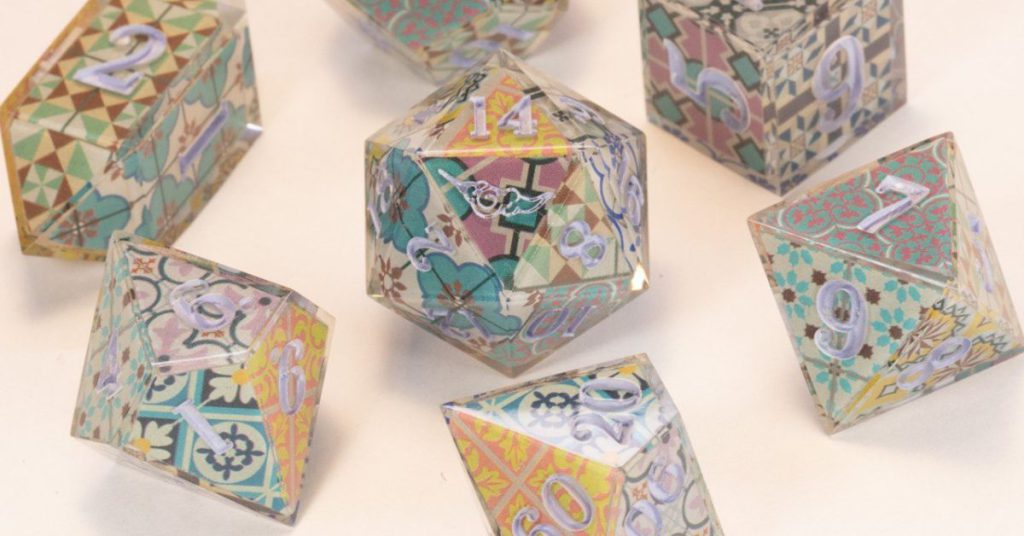
They turned to online tutorials, but ended up essentially learning from scratch. This was because they couldn’t find anyone in Singapore, or Southeast Asia, really making artisanal dice.
Realising a gap in the market for artisan dice in the region, they decided to start Sambal & Mages.
Most dice-makers are based in the Western hemisphere, resulting in exorbitant shipping fees. And beyond offering a more economical option, they also wanted to put a local spin to their offering.
“The dice and our brand became a medium for sharing with D&D’s predominantly Caucasian community what we had to offer,” they explained.
“From dice inspired by Singapore’s fishing village history to coming up with prompts for Hari Raya-related D&D adventures, we knew that the space we were occupying could pave the way for even more Southeast Asian representation in D&D.”
Throwing the dice
As far as they’re aware, Sambal & Mages is Singapore’s first handmade dice maker.

They started out by bootstrapping, but later met a fellow D&D player who believed in their mission, and generously provided them a bit of startup capital.
Looking at the resin dice, you might think the process is relatively simplistic—at least I did. But I was sorely mistaken.
“Making dice isn’t like those hobby resin projects you see online,” the team said. “The 3D nature of dice required a whole different approach, and different moulds to boot. We couldn’t just pour resin into an open mould and leave it to cure. “
Instead of using a generic set of moulds bought online, they created masters to cast their unique dice. And after that, they had to battle with Singapore’s humidity to ensure the dice cured properly.
“Typically, the entire process from start to finish takes about a week or so, depending on whether or not the resin decides to behave during the curing process,” they said.
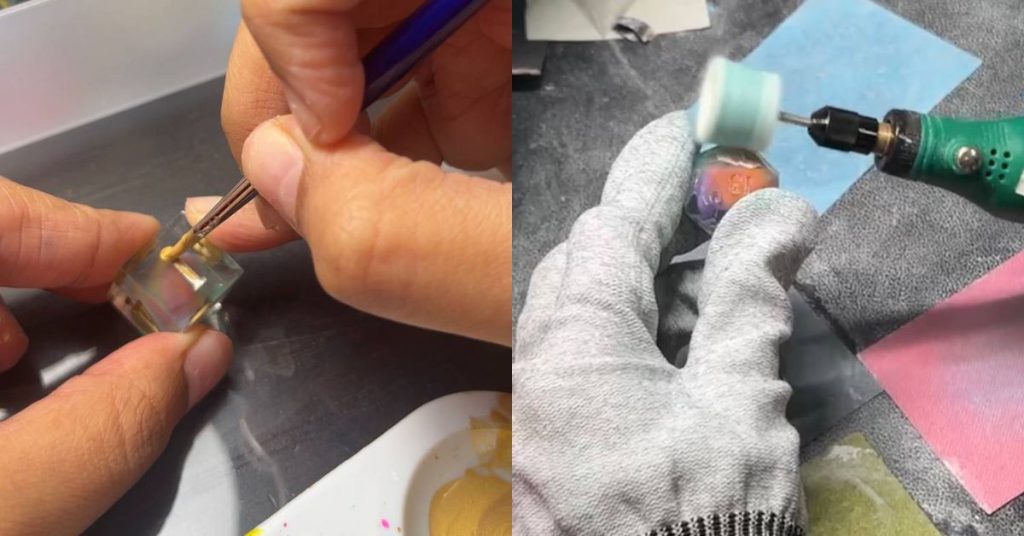
Unable to find a pressure pot in Singapore, they ended up making one, sourcing components like valves and compressors one by one. Pressure pots are used to remove air bubbles in resin, leading to a clear result.
Balance and accuracy must also be considered to ensure the dice roll fair. For one, they must make sure the sanding and polishing is done evenly.
Sambal & Mages’ handmade dice sets go for S$150, while a single 50mm D20 die is S$80.
“The profit margins are unfortunately not very high seeing that our materials and resources are expensive to begin with,” they opened up.
However, the team struggles with increasing price points as accessibility and affordability are important to them.
Finding and fostering a global community
“The TTRPG community in Singapore is small but strong,” Sambal & Mages shared. “Just like the different races and classes in D&D, it’s also very, very diverse.”
Sambal & Mages further taps into this community at in-person events like SG Comic Con.
“As a ballpark, we see around 250% more profit at the con than any launch we would have done online,” they said.

Interestingly, team has received a lot of the demand and support not just locally, but from around the world.
As the community grows, though, so might competition. While Sambal & Mages claims to be the first artisan dice maker locally, they may very well not be the last.
The team said that there are a few suppliers locally that offer factory-made dice, but when it comes to having a premium, artisanal product at the game table, they are the go-to brand.
“On a global level, with heaps of dice makers around the world, we offer the Southeast Asian perspective to the D&D universe,” they expressed. “We offer our grandmother’s stories, the flavours at our dinner table, and the colours on our streets.”
A one-stop hobby shop
Starting with dice, Sambal & Mages has now expanded to more offerings including earrings, necklaces, stickers, T-shirts, and more.

These expansions arose out of demand from friends and followers of the brand.
“Dice are really the ‘main character’ at the table when it comes to TTRPG, but there are so many products that a player can have that enriches their game for them,” the team said.
Going forward, the team is considering the possibility of becoming a one-stop shop for adventurers everywhere looking for a Southeast Asian spin on their TTRPG experience.
They elaborated, “This could extend beyond physical products into something like lore-writing, where we expand the D&D universe as we know it to include references from the region and offer a taste of what actual dungeons and mythical dragons look like on this side of the world.”
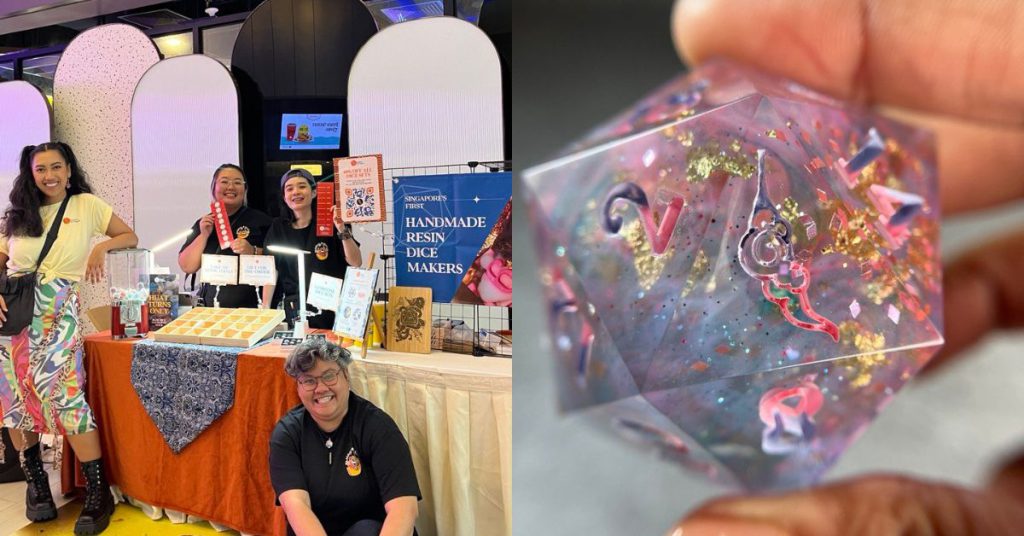
However, obstacles that stand in their way are time and energy—or the lack thereof.
“Our main challenge so far has been to avoid burnout honestly. We’re in very rigorous industries outside of Sambal & Mages so it can be tough trying to find balance between paying the bills, working on what we love, and sleep.”
Still, the team persists, believing in the vision of Sambal & Mages. As the business grows, they might just be able to turn it into their full-time commitments.
- Learn more about Sambal & Mages here.
- Read other articles we’ve written about Singaporean startups here.
Also Read: The Tokyo govt wants to grow MY & SG startups in Japan, here’s how entrepreneurs can benefit
Featured Image Credit: Sambal & Mages
Why this S’porean shut down her popular book cafe for kids just 1 yr after launching it
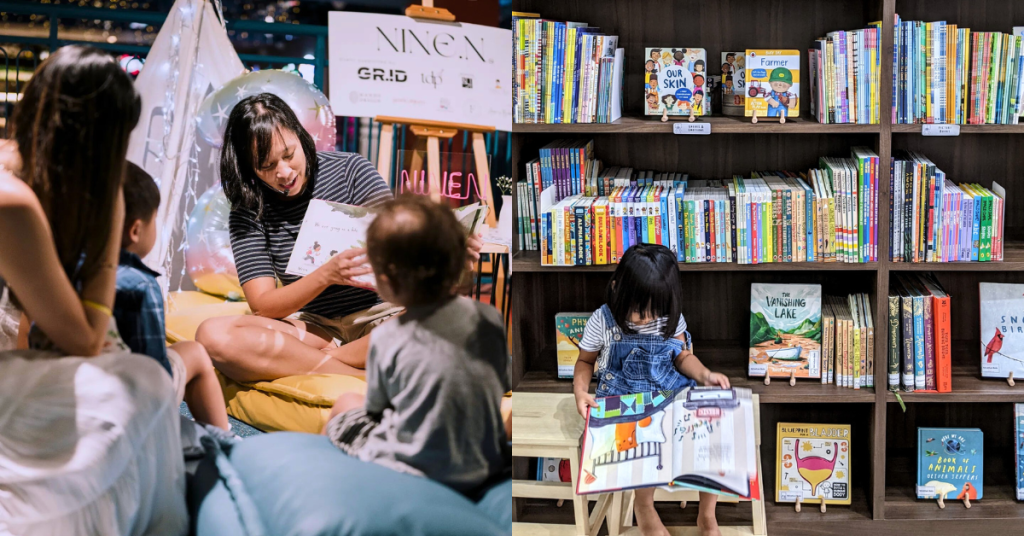
“If anyone said anything about the practicality of opening a book cafe, I would have never started it,” Cecilia Koh confided to us.
It wasn’t really her initial business plan to open a children’s book cafe either. In fact, she described it as an impulsive decision.
But the book cafe idea wasn’t born out of nothing.
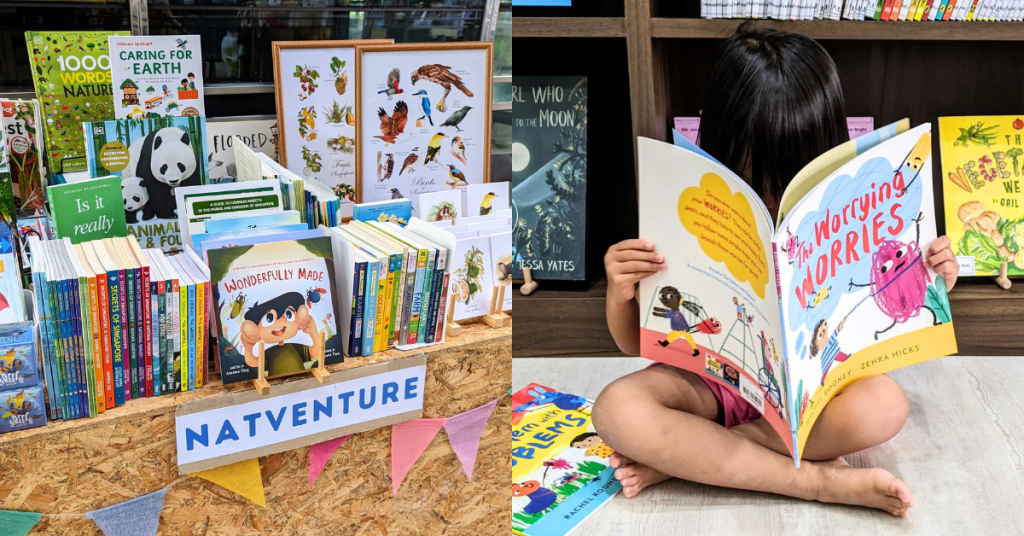
At the time, Cecilia had already founded and was single-handedly running Natventure. It’s an online independent bookstore for kids with a key curation on nature and adventure-themed books.
One year into the business, she got the idea to expand it physically into a book cafe. Believing her book cafe concept was unique enough, Cecilia didn’t think much about the actual implementation.
“Because my friend was also equally excited about the idea, we decided to [just] go for it,” she shared.
That’s how Natventure Book Cafe opened at Syed Alwi Road in 2020.
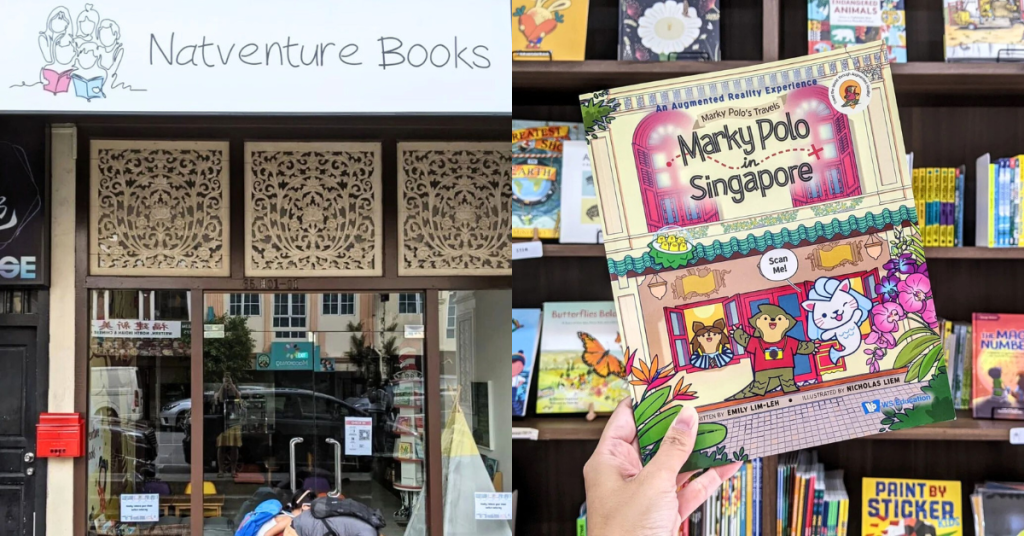
Nurturing independence in children
With three young kids of her own, Cecilia is well aware of the challenges that come with bringing children out.
“Not to mention, the judgement we may face when children don’t display behaviours deemed proper by society in general, like sitting still and talking softly,” she explained.
So the concept for Natventure Book Cafe was to create a safe and child-friendly space where the young ones’ experiences were prioritised.
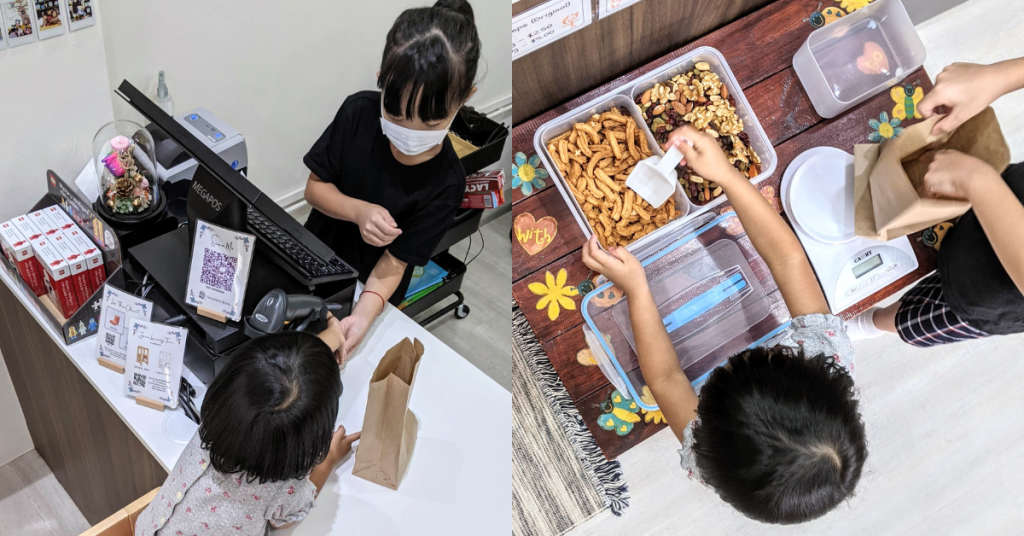
“We believe that children are capable individuals and we wanted our space to allow children the freedom to express their independence within reasonable limits.”
Cecilia and her friend designed the book cafe with low floor seating for children to move around freely. Visitors could even bring their own mats to lay down their babies while they dined at the cafe.
In terms of the cafe, there was a learning tower provided so that children could interact with adults at the same height level.
Children were encouraged to place orders for the cafe’s drinks and cakes on their own, with photos of the F&B offerings shown in the menu to help make the process easier. There were also little trays with handles for the kids to carry the food back to their seats.
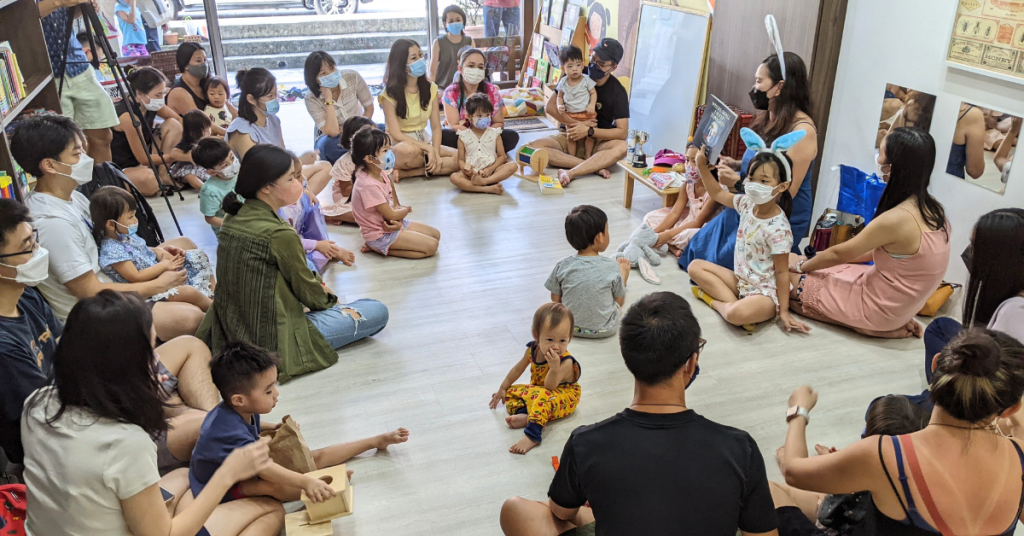
It was this approach and attentiveness to children’s independence that made Natventure Book Cafe quite popular. So much so that the demand eventually outweighed what they could deliver.
Knowing when to say goodbye
When Cecilia envisioned the book cafe, her key focus was to offer good books and book-related events. The F&B aspect came second to that so Natventure Book Cafe wasn’t very well prepared to run it.
This later turned into a bit of a problem.
“After running the book café for a while, we realised there was more demand for F&B such a setting that we curated for children. And even the renting of venues for kids-related parties and events,” she shared.
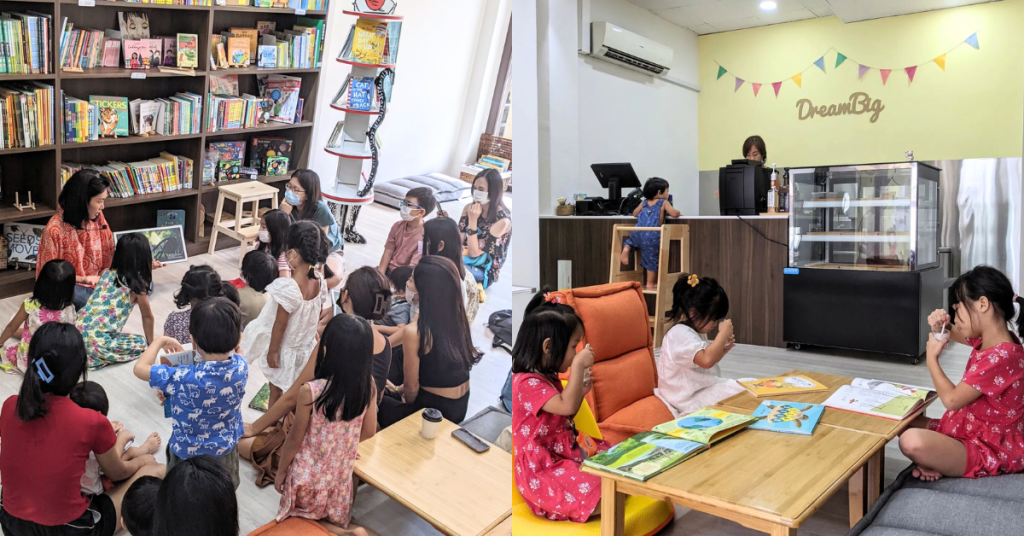
Unfortunately, the book cafe couldn’t cater to such demands because it didn’t have the right facilities. For example, the electricity load wasn’t enough to power more efficient kitchen equipment like commercial dishwashers.
It was also during this period that Cecilia’s personal life became a little hectic.
Shortly after giving birth to her third child, she took the role of a caregiver to another family member. This meant that both she and her husband went from taking care of two to now four other people.
“Even without a business to run, it was still a very challenging period and transition for us,” she recalled. Realising that there was just too much on her plate, she unwillingly rolled up the book cafe.

Properly focusing on her niche
“I was upset and disappointed to shut down the book cafe, and felt like giving up the whole business entirely. Especially in view of what was going on in my personal life,” the founder divulged. “It was so tough, mentally and emotionally.”
But the support of her husband, friends, and other entrepreneurs she’s met along the way kept her going.
Despite shuttering Natventure Book Cafe, Cecilia realised that this wasn’t the end of her entrepreneurial journey. She still had the original online bookstore which is actually her real passion.
So she took some time to restrategise and come up with a business plan that seems to be working out better for her.
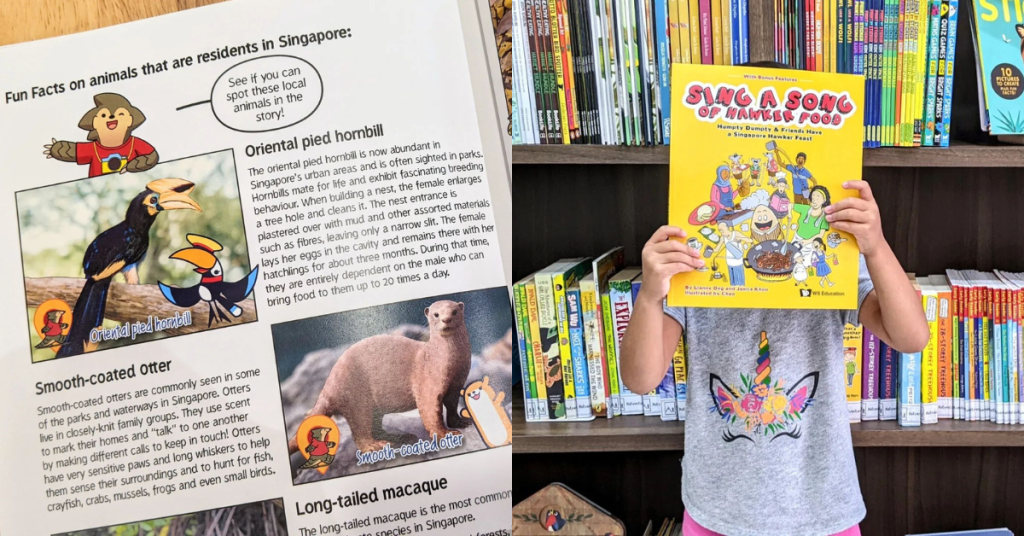
Now, Natventure focuses on building a community of international readers from the younger generation. It offers local authors and Singaporean stories to enrich their appreciation for our culture.
Another way she accomplishes this is by collaborating with agencies to curate unique experiences for young readers. For example, last year she set up a pop-up roving bookstore in partnership with Singapore Art Museum.
She also occasionally does storytelling sessions with children at other stores like the East Coast Commune cafe.
With a clearer vision of how she wants the brand to be, Natventure continues to work towards that, and Cecilia has put the book cafe out of mind… for now.
“My interest is in books and in creating spaces/experiences for children where they can feel free and empowered. But if there’s an F&B establishment that would like to recreate a similar space together, I’m open to discussing,” she shared.
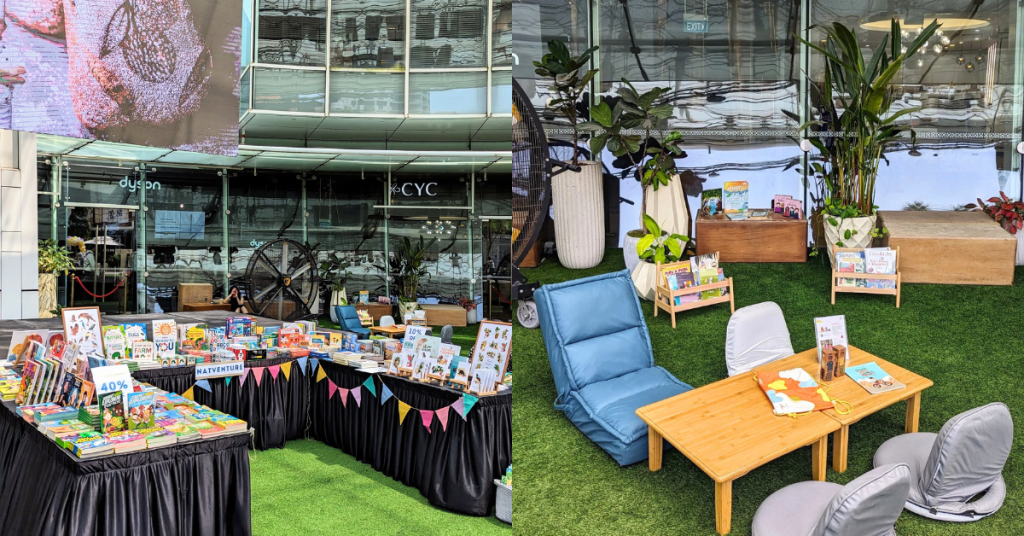
Also Read: The Tokyo govt wants to grow MY & SG startups in Japan, here’s how entrepreneurs can benefit
Featured Image Credit: Natventure

